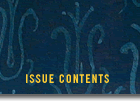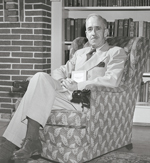


 |
 |
|
Around Tappan Square :: Page 8 :: Faculty In The Field
Jump to Page 1 : 2 : 3 : 4 : 5 : 6 : 7 : >8< : 9 : 10 of ATS
Faculty In The Field: The Wartime Diary of a Spanish Professor
by Sebastiaan Faber, Department of Hispanic Studies
 Civil war in Spain erupted in 1936, when discontented military leaders—supported
by Hitler and Mussolini— attempted to overthrow Spain’s
leftist Republican government. The conflict immediately captured the
attention
of the Western world and stirred up passionate debates everywhere.
Civil war in Spain erupted in 1936, when discontented military leaders—supported
by Hitler and Mussolini— attempted to overthrow Spain’s
leftist Republican government. The conflict immediately captured the
attention
of the Western world and stirred up passionate debates everywhere.
Those on the political left viewed the war as a struggle between democracy and fascism; those on the right, as a fight against Soviet communism. Oberlin was not immune to the war, for it changed forever the lives of Spanish Professor Paul P. Rogers and Col-lege sophomore Paul MacEachron. Rogers, a staunch antifascist, spent a month in wartime Spain in the summer of 1937. MacEachron, the son of an Oberlin athletics coach, joined the American volunteers fighting for the Republic and died on the Spanish battlefield in 1938.
The Spanish Civil War continues to spark debate at Oberlin. A seminar taught last year by Visiting Assistant Professor of History Lisa Abend ’85 stirred up almost as much political passion as the war itself. Geoff Pingree, assistant professor of cinema studies and English, is completing a book on Civil War documentaries and how they shape public perception of history. I myself have been researching the impact of the Civil War on the work of Rogers and other Hispanists during the 1930s; specifically, how these individuals balanced scholarship and teaching with their love of Spain and the rise of fascism.
As longtime chair of the Spanish department and a professor from 1929 to 1966, Rogers laid the foundation for Oberlin’s current Department of Hispanic Studies. His son, Douglass Rogers ’51, emeritus professor of Spanish at the University of Texas, returned to campus recently to speak about a diary that his father wrote while in Spain during the war.
Titled “Spanish Journey,” the journal covers 17 days of Rogers’ firsthand war experiences. It begins in August 1937, when Rogers was invited to serve as a war observer on the side of the government of the Second Spanish Republic. In Paris, he joined a 13-member international aid delegation to Republican Spain. On August 8, the group departed for Valencia, where they were received by Spanish President Manuel Azaña himself at the presidential palace.
While in Valencia, Rogers and the others attended a reception hosted by Prime Minister Juan Negrín. They visited a children’s home for war orphans and then a prison, where they engaged in extensive conversations with Italian and Moorish prisoners of war who talked of their disillusionment of the Nationalists.
On August 11, Rogers was surprised to find his friend, American poet Langston Hughes, joining the delegation on a bus trip to Madrid. During a lunch stop at Tarancón, the two men, accompanied by another American, visited a hospital, where they talked with victims of the devastating battles of Guadalajara and Brunete.
As they entered Madrid, Rogers noted his surprised impression of a city in peace: “As we drove to the hotel, all was strangely quiet and in good condition,” he wrote. During the following days, however, the group began to see signs of a city under siege, including the sounds of bombs and rifle fire. They toured the city, first by bus through omnipresent barricades, then on foot through trenches around the University Circle area. This had been the site months earlier of the fierce battle for Madrid, where hand-to-hand combat had been fought through classrooms and laboratories.
As Rogers and the others toured the city under the cover of some still-standing buildings, they were surprised by enemy fire, described as “sporadic and desultory firing by snipers, with the occasional rattle of machine gun fire.” The group sought refuge in underground trenches where, through viewing slits, they “observed the enemy a few hundred feet away.”
Later, during a trip to an army base in nearby Alcalá de Henares, the delegation reviewed troops with Republic military general José Miaja, prompting Rogers’ observation, “This is a peasants’ and workers’ army. No parade army.” At his hotel in Madrid, he was visited by another old friend, the Spanish poet León Felipe.
During a return trip to Valencia, Rogers chatted at length with one of the war’s most colorful figures, the guerrilla fighter El Campesino (Valentín González). He toured some schools located in the barracks: “They have (schools) also in the hospitals, factories, and trenches,” he wrote. “All ages of people attend and study everything from the ABCs to anatomy to art. Schools near the front are often camouflaged. The instructors fight as well as teach.”
While visiting a women’s prison, he was surprised by the “notoriety” of the inmates: close relatives of famous Nationalist generals Francisco Franco, Queipo de Llano, and Millán Astray.
The journal closes abruptly with this observation: “I had a sample of the olla which was being prepared for the prison meal. Good!”
In later years, Rogers became a frequent visitor to Mexico City, where he joined Spanish Civil War expatriates—mostly writers and artists—in regular gatherings.
:::::
If you have memories of Paul Rogers or Paul MacEachron, please contact Sebastiaan Faber at Sebastiaan.Faber@oberlin.edu or at the Department of Hispanic Studies, 50 N. Professor, St., Oberlin, OH 44074. Thanks to Douglass Rogers for providing material for this column.
![]()